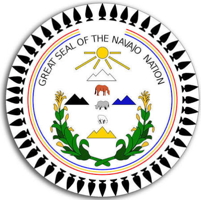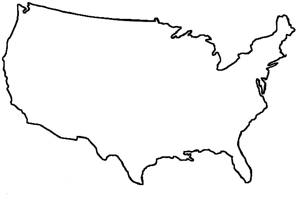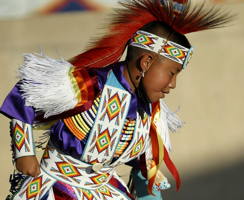
|
The Society of Folk Dance Historians (SFDH)
Navajo Tradition Keepers (Yeh' Bi Che')
[
Home |
About |
Encyclopedia | CLICK AN IMAGE TO ENLARGE |

|
 From what I have seen in the time I have been here, the Navajo-Apache community is possessed of a very fine and widespread dance culture. The dance acceptance among the Navajo is "traditional," religious and secular, ancient and modern. The religious aspect is clan- and family-oriented ceremonial rites and beliefs that edges over into the area of secular-social type, and fun and courtship, at many points in the life of the participant.
From what I have seen in the time I have been here, the Navajo-Apache community is possessed of a very fine and widespread dance culture. The dance acceptance among the Navajo is "traditional," religious and secular, ancient and modern. The religious aspect is clan- and family-oriented ceremonial rites and beliefs that edges over into the area of secular-social type, and fun and courtship, at many points in the life of the participant.
The medicine man (traditional Navajo psychiatrist) sings the songs of a ceremonial rite to help an individual or group of dancers perform an act of spiritual significance. The dancers, a family of clan relatives and brothers, dance to the rhythm of the singer, and they will sing on cue, in unison, usually without harmony. The "cantor" puts everything into the song after reaching points of intensity and spiritual delivery in the true tradition of the outstanding religious singers (who have not yet reformed to become esoteric and snide-mannered intellectuals), because everyone present truly knows and is at-one-moment with "the spirit." Thus the belief of each participant is reinforced, and acts of real healing and an uplift of courage and morale takes place. The movements and dances of the ceremonial rite are in a prescribed sequence and often take several days to complete. The lead singer as well as his helpers should be in very good health, as this kind of dance is usually given for the purpose of healing the sick. There are other rites, however, for every conceivable human condition. The singer is usually paid for his services. As a "priest," however, he performs a variety of roles besides that of a "cantor."
 There are a number of dances in which groups perform for competition only. Traditionally, the costume for this type of dance is the same for all through the Arizona-New Mexico area, so it is almost impossible for a newcomer and outsider to know one group from another unless he knows the dancers personally. There is no specific dress to distinguish clan from clan. The dances depict legendary historical and religious themes, and are danced alike by all groups. Only an expert, long-time Navajo dancer can judge the values and point counts of these dances, and to the groups participating, winning in this secular-religio competition is a keen desire.
There are a number of dances in which groups perform for competition only. Traditionally, the costume for this type of dance is the same for all through the Arizona-New Mexico area, so it is almost impossible for a newcomer and outsider to know one group from another unless he knows the dancers personally. There is no specific dress to distinguish clan from clan. The dances depict legendary historical and religious themes, and are danced alike by all groups. Only an expert, long-time Navajo dancer can judge the values and point counts of these dances, and to the groups participating, winning in this secular-religio competition is a keen desire.
On the reservation, one will find that Square Dances are popular at some of the schools, while at others, a modern Rock is "in," but the dance that seems to be liked by all the people in Navajoland is called Stomp, and is a slowed-down version of Jitterbug with perhaps a few instances of Bop. A left-over from World War II days, Stomp is danced to a to a medium, slow, and up-tempo country-Western-style rock band. All along Interstate 40 in Arizona, and across into New Mexico, wherever the coffee shops, roadhouses, saloons, and beer halls have signs announcing dancing, Stomp is what they mean unless otherwise specified.
Many Pow-Wow conferences are held in the Native American communities. These are, like our festivals, an excuse for people to get together, talk, and see and be seen. At a Pow-Wow, it is fancy pants and Western boots for the men, and traditional skirts and stylish mod for women. Everyone who is rich enough piles on all his silver and turquoise. (Some beautiful examples of Native American turquoise artistry may be seen in the magazine "Arizona Highways.") Often speakers come by invitation to address the conference-talk session. A Pow-Wow Queen is usually chosen, prizes given, and the competition dancers will perform. The oldsters will watch the young people dance modern "Stomp" or "Rock" (depending upon the community), and some special exhibition groups may perform. During the day, a rodeo is held. Announcements of upcoming Pow-Wows and many other entertainments and social events are printed in the "Navajo Times," a bi-weekly newspaper, and announced on radio and television in Navajo, English, and Spanish.
At some schools, a conflict has arisen over the problems of dances, music and costumes, in the manner of traditional (authentic?) versus the new. The up and coming of Stomp, and especially the somewhat massively traumatic experience of Rock is often viewed as an attack upon the spirit of the people. Tradition welds religion and secular life so close together that there is no middle ground. Many of the young (most, in fact) are as traditional as their parents, and feel estranged from those other young people who affect the "mod" style, belittling them and trying to shame them. But whoever has experienced modern dancing (especially free swinging Jazz or Rock) has turned away from tradition forever. Dancing in a non-ceremonial form is for babies and white people, however, and no cool, sophisticated, adult Navajo would be caught dead making all those pelvic-region movements without any ceremonial or spiritual purpose other than to have fun with his friends!
Navajo folk art is carried on by a number of groups of older people who keep the traditional culture and religion up to date. They are called "Yeh' Bi Che'," which is the name given to the music, dance, and poetry of psalms sung to cleanse the spirit, to the priest of the religion, to the young folk who dance and the older ones who teach them, and to the ceremony of prayer, song, and dances – these are all encompassed by this single term. And it is through "Yeh' Bi Che'" that Navajo traditions will be preserved for future generations.
DOCUMENTS
- Native American, an article.
- Native American Affairs, an article.
- Native American Dance, an article.
- Native American Dances, an article.
- North America, a region.
Used with permission of the author.
Printed in Folk Dance Scene, Februarry 1974.
This page © 2018 by Ron Houston.
Please do not copy any part of this page without including this copyright notice.
Please do not copy small portions out of context.
Please do not copy large portions without permission from Ron Houston.